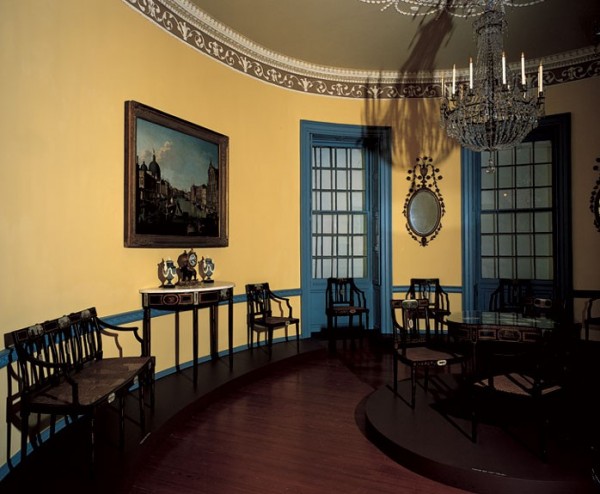
The Morris suite of painted furniture shown in the oval room from Willow Brook—one of the houses depicted on the furniture—now installed in the Baltimore Museum of Art. (Courtesy, Baltimore Museum of Art; gift of the city of Baltimore, installation and renovation made possible by contributors to the Willow Brook Fund.) The card table in the center of the room is from the Buchanan suite.
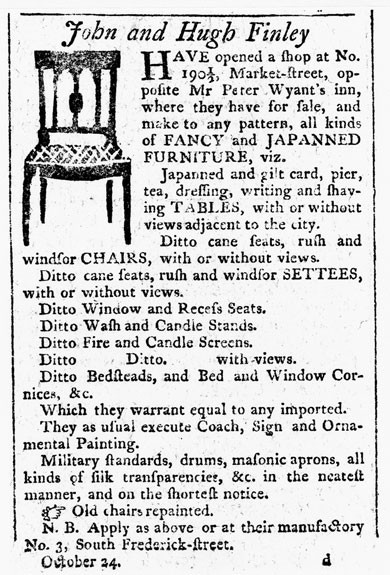
Advertisement by John and Hugh Finlay in the October 24, 1803, issue of the Federal Gazette & Baltimore Daily Advertiser. (Courtesy, Maryland Historical Society.) This advertisement for the Finlay firm depicts a side chair of the same form as the armchairs in the Morris suite, with the splat in the form of two gothic-arched panels flanking a central tablet.
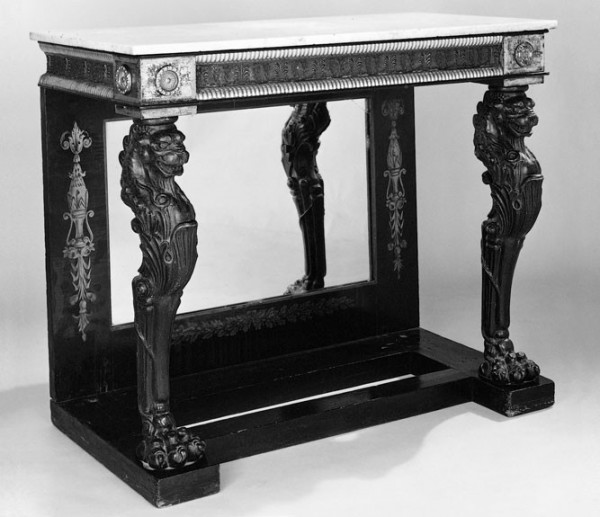
Pier table, Baltimore, Maryland, 1815–1830. Yellow pine and maple; rosewood graining, gilt plaster, hollow cast lead (monopedia), ormolu, and glass. H. 37 1/4", W. 45", D. 23 1/8". (Courtesy, Baltimore Museum of Art; bequest of Elizabeth Curzon Hoffman Wing, in memory of Hanson Rawlings Duval, Jr.) The description of Robert Gilmor, Jr.’s pier table suggests that this form may date earlier than traditionally believed.

Sofa illustrated in Catalogue of the Celebrated Dr. William H. Crim Collection of Genuine Antiques, To be Sold . . . In the Fourth Regiment Armory, Beginning Wednesday, April 22d 1903 (Baltimore, Md.: A. O. Kirkland, 1903), lot 1127.
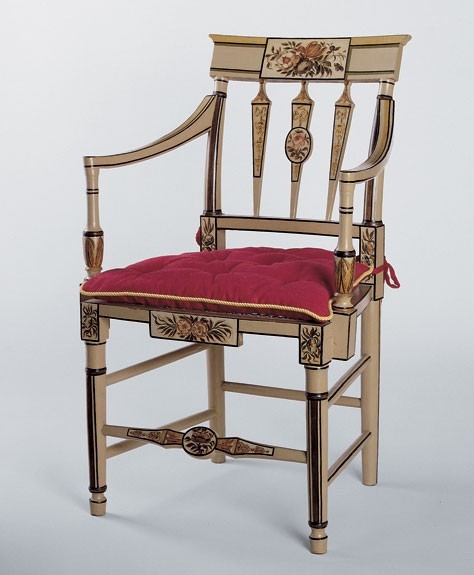
Armchair, Baltimore, Maryland, 1800–1806. Maple and walnut . H. 32 3/4", W. 21", D. 16". (Collection of Hampton National Historic Site, National Park Service; photo, Gavin Ashworth.).

Detail of the decoration on the crest rail of the armchair illustrated in fig. 5. (Photo, Gavin Ashworth.) Unlike the houses on the Morris suite, decorations like that on the crest rail of this chair could have been painted by a craftsman from images in pattern books.

Side chair, Baltimore, Maryland, 1810–1820. Maple and cherry. H. 34", W. 20 1/2", D. 24 1/4". (Collection of Mrs. George M. Kaufman; photo, Gavin Ashworth.) Recent pigment analysis indicates that this suite of chairs is painted with chrome yellow. In 1814 Robert Gilmor wrote that chromate of iron was found in the Bare Hills area seven miles north of Baltimore on the Falls turnpike: “Perhaps in no part of the world has so much been discovered at one place: it furnishes the means of preparing the beautiful paint called the chromic yellow, with which carriages and furniture are now painted in Baltimore.” Gilmor’s observation that the pigment was used on carriages and furniture suggests that the Finlays—who worked in both trades—may have been using chrome yellow as early as 1813. Considering the abundant local supply, the use of this pigment may have reflected local pride. See Robert Gilmor, Jr., “A Descriptive catalogue of Minerals occurring in the vicinity of Baltimore,” American Mineralogial Journal 1, no. 4 (1814): 231–32. In 1818 Gilmor presented examples of granular and octahedral chromate of iron from the Bare Hills to the British Museum. He noted that the octahedral examples were the first “that had ever been seen in Europe” (Henry Ellis, British Museum, to Robert Gilmor, Jr., January 10, 1818, private collection).
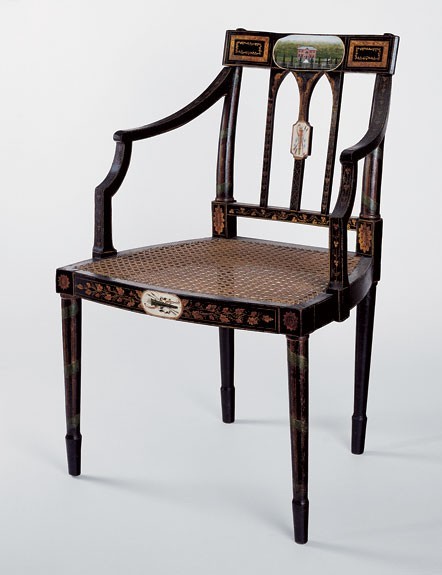
Armchair attributed to the shop of John and Hugh Finlay with crest rail medallion attributed to Francis Guy, Baltimore, Maryland, 1803–1805. Maple and ash. H. 33 3/4", W. 21 5/8", D. 20 15/16". (Courtesy, Baltimore Museum of Art, gift of Lydia Howard de Roth and Nancy H. DeFord Venable in memory of their mother Lydia Howard DeFord and Purchase Fund; photo, Gavin Ashworth.)
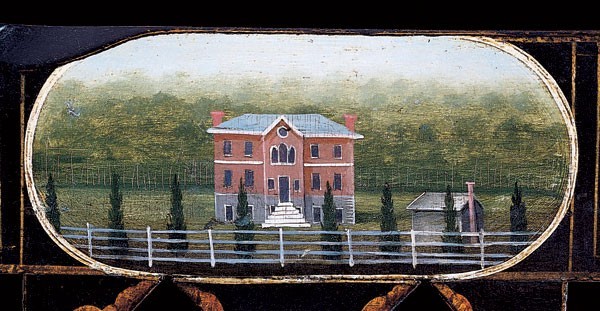
Detail of the decoration on the crest rail of the armchair illustrated in fig. 8. (Photo, Gavin Ashworth.)
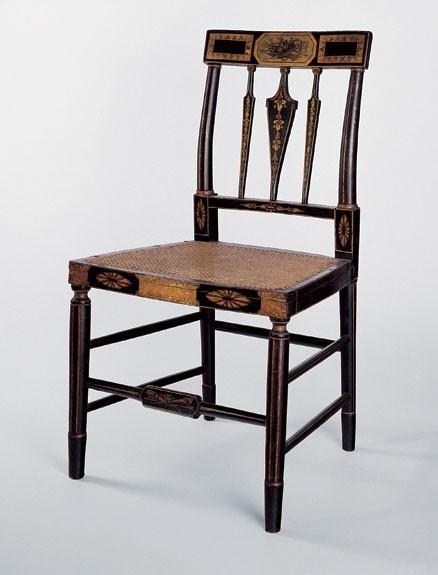
Side chair attributed to the shop of John and Hugh Finlay, Baltimore, Maryland, 1803–1806. Maple, ash, and mahogany. H. 33 1/4", W. 19", D. 19 1/4". (Courtesy, Baltimore Museum of Art, George C. Genkins Fund by exchange; photo, Gavin Ashworth.) This chair is from the Buchanan suite.
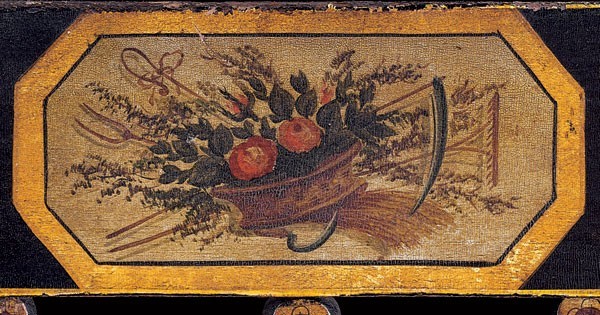
Detail of the decoration on the crest rail of the side chair illustrated in fig. 10. (Photo, Gavin Ashworth.)
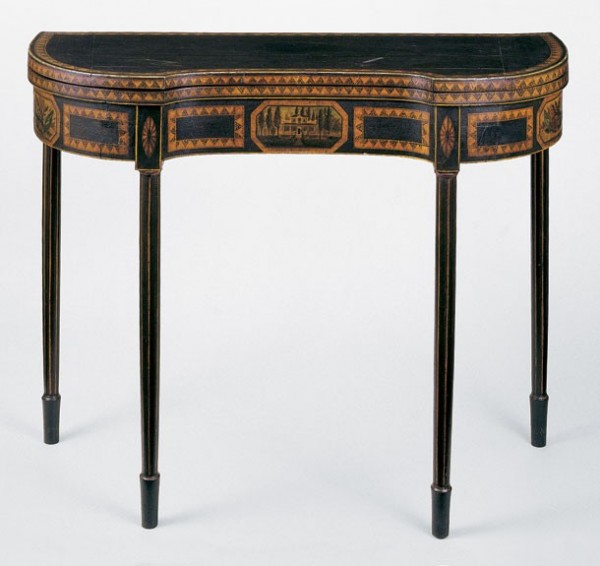
Card table attributed to the shop of John and Hugh Finlay with skirt medallion attributed to Francis Guy, Baltimore, Maryland, 1803–1806. Maple and mahogany veneer with yellow pine and oak. H. 30 3/8", W. 38 3/4", D. 17 3/16" (closed). (Courtesy, Baltimore Museum of Art, Friends of the American Wing Fund; photo, Gavin Ashworth.) The mate to this table from the Buchanan suite is illustrated in figs. 32 and 33.

Detail of the decoration on the skirt of the card table illustrated in fig. 12 showing the panel depicting a country house of the Buchanan family of Baltimore. (Photo, Gavin Ashworth.)

Pier table attributed to the shop of John and Hugh Finlay with skirt medallion attributed to Francis Guy, Baltimore, Maryland, 1803–1806. Yellow pine, tulip poplar, and maple. H. 35 7/8", W. 45 1/8", D. 20". (Courtesy, Baltimore Museum of Art, George C. Jenkins Fund by exchange; photo, Gavin Ashworth.) This pier table is from the Buchanan suite.

Detail of the decoration on the skirt of the pier table illustrated in fig. 14. (Photo, Gavin Ashworth.) This panel depicts houses on Gay Street traditionally thought to have been built by William Buchanan for his daughters.
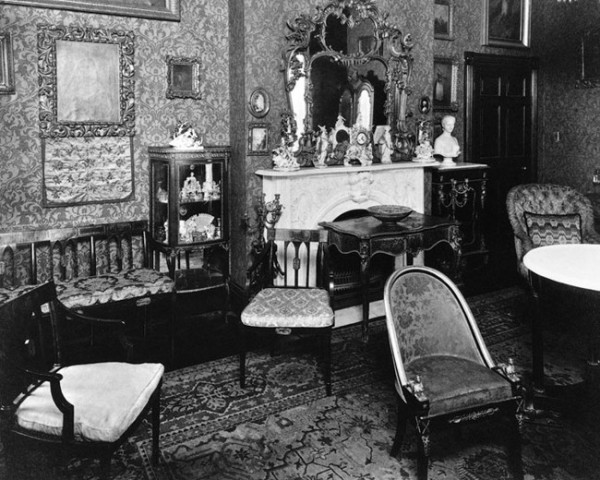
Circa 1927 photograph of the interior of 401 North Charles Street, Baltimore, Maryland. (Courtesy, Maryland Historical Society.) This view shows the “yellow drawing room” in the residence of the Frank Key Howard family. The settee with Montebello depicted in the center of its crest rail and two chairs from the Morris suite are visible. One of the chairs has Grace Hill depicted on its crest rail.
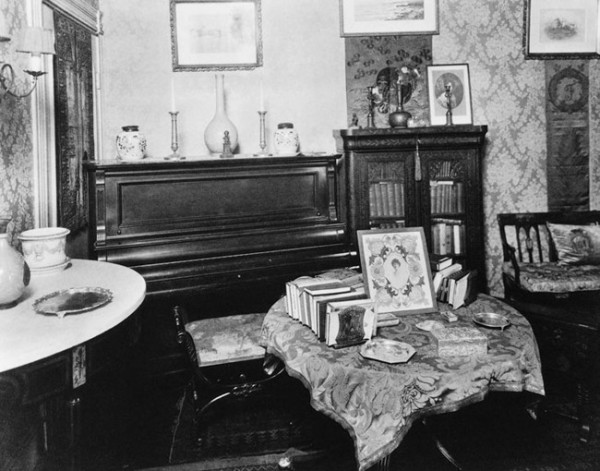
Circa 1927 photograph of the interior of 401 North Charles Street, Baltimore, Maryland. (Courtesy, Maryland Historical Society.) This view shows the “pink room” in the residence of the Frank Key Howard family. The settee with the Banks of the City depicted in the center of its crest rail and the pier table from the Morris suite are visible in the far right and left.

Lillian Causey, rendering of an armchair from the Morris suite, ca. 1936. Watercolor, gold ink, and graphite on paper. 14" x 10 1/2". (Courtesy, National Gallery of Art, Washington. acc no.1943.8.4390.) Charles Morris Howard owned this chair when Causey painted it.

Manuscript list titled “Names of Country Seats/ on the Clermont Furniture,” Baltimore, Maryland, probably early twentieth century. (Courtesy, Baltimore Museum of Art; photo, Gavin Ashworth.)

Continuation of manuscript list titled “Names of Country Seats/ on the Clermont Furniture,” Baltimore, Maryland, probably early twentieth century. (Courtesy, Baltimore Museum of Art; photo, Gavin Ashworth.)

Detail showing the “1” mark on the rear seat rail of the armchair with Belvidere depicted on its crest rail (app. 1). (Photo, Gavin Ashworth.) The slant of the numbers on the Morris suite is similar to that of the numbers on the manuscript lists illustrated in figs. 19 and 20. These numbers may be by the same hand.
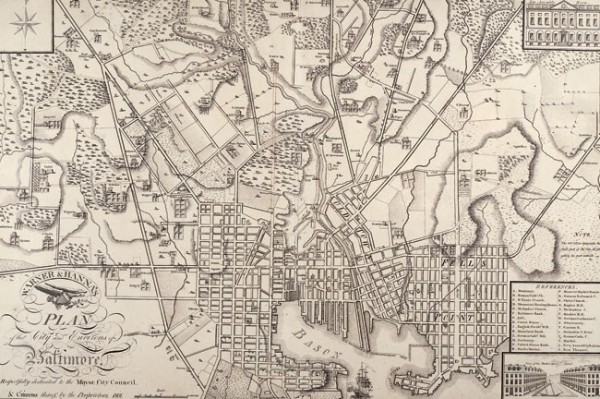
WARNER & HANNA’S PLAN of the City and Environs of Baltimore Respectfilly dedicated to the Mayor City Council and Citizens thereof by the Proprietors, 1801. (Courtesy, Maryland Historical Society.)
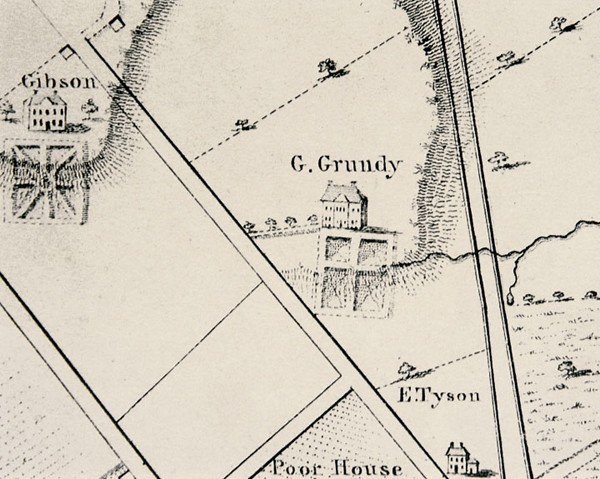
Detail of the map illustrated in fig. 22 showing William Gibson’s house Rose Hill northwest of George Grundy’s house Bolton. Both houses are similarly depicted on chairs in the Morris suite.
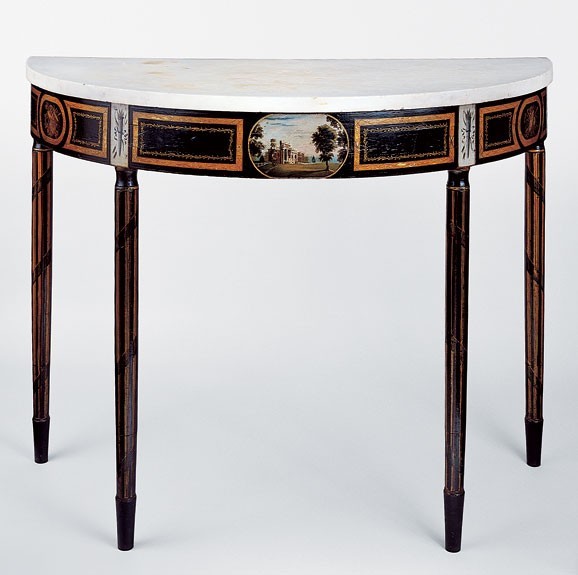
Pier table attributed to the shop of John and Hugh Finlay with skirt medallion attributed to Francis Guy, Baltimore, Maryland, 1803–1805. Maple; marble. H. 36 3/8", W. 48 3/8", D. 24 3/8". (Courtesy, Baltimore Museum of Art, gift of Lydia Howard de Roth and Nancy H. DeFord Venable in memory of their mother Lydia Howard DeFord and Purchase Fund; photo, Gavin Ashworth.)

Detail of the decoration on the skirt of the pier table illustrated in fig. 24. (Photo, Gavin Ashworth.)
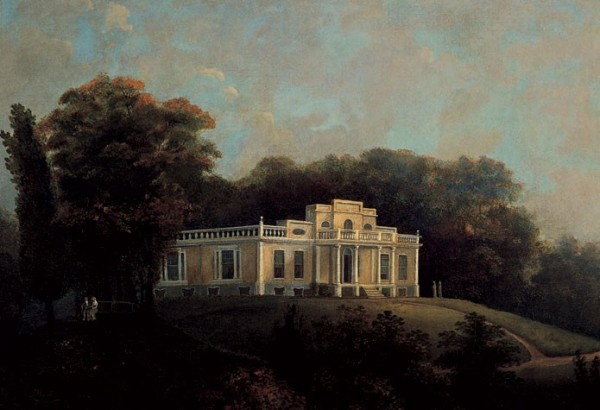
Francis Guy, View of the Seat of Colonel Rodgers, Near Baltimore, ca. 1811. Oil on canvas. 18 7/8" x 31 3/4". (Courtesy, Maryland Historical Society; bequest of Mrs. Geneva D. Richardson.) Guy eliminated some details. By 1811 Druid Hill was stuccoed and painted yellow.

Circa 1860 photograph of Druid Hill. (Courtesy, Maryland Historical Society.) This image shows the house with the front portico largely removed at the time the dwelling was being converted into a pavilion for Druid Hill Park.

Charles-Balthazar-Julien Févret de St. Mémin, Harriet Rogers, Baltimore, Maryland, ca. 1806. (Courtesy, Maryland Historical Society; gift of Helen Hubbard, Mrs. Walter Oakman, and the estate of Mrs. J. H. Ten Eyck Burr.) While in Baltimore, Saint-Mémin depicted several sitters with landscape backgrounds. Of the firmly identified images, that depicting Harriet Rogers, the daughter of Nicholas and Eleanor Rogers, is the only one in which a residence of the sitter is shown, suggesting that the Rogers family strongly identified themselves with Druid Hill.
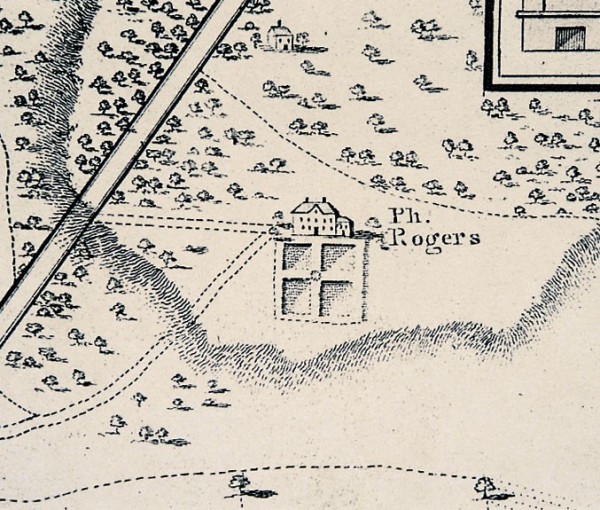
Detail of the map illustrated in fig. 22 showing Philip Rogers’ house Greenwood. The house apparently burned shortly after this map was made and was replaced by another structure of a different form.
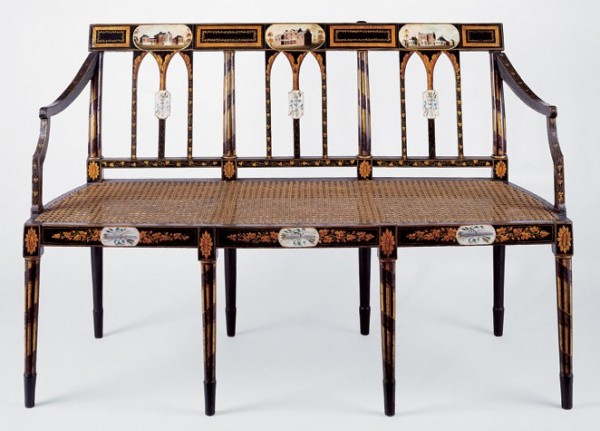
Settee attributed to the shop of John and Hugh Finlay with crest rail medallions attributed to Francis Guy, Baltimore, Maryland, 1803–1805. Maple and ash. H. 33 7/8", W. 51 3/16", D. 22 1/8". (Courtesy, Baltimore Museum of Art, gift of Lydia Howard de Roth and Nancy H. DeFord Venable in memory of their mother Lydia Howard DeFord and Purchase Fund; photo, Gavin Ashworth.)
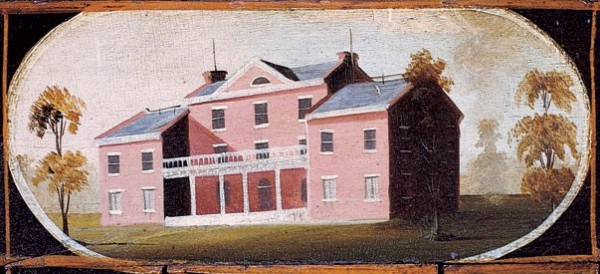
Detail of the central panel on the crest rail of the settee illustrated in fig. 30 showing the building housing the Banks of the City. (Photo, Gavin Ashworth.)
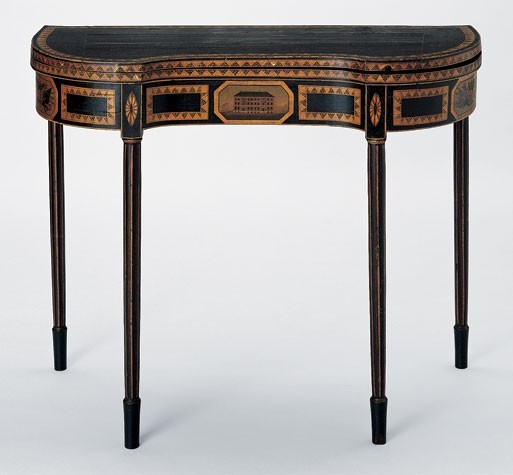
Card table attributed to the shop of John and Hugh Finlay with skirt medallion attributed to Francis Guy, Baltimore, Maryland, 1803–1806. Tulip poplar and pine with oak. H. 28 3/4", W. 38 5/8", D. 17 1/2". (Courtesy, Winterthur Museum; bequest of Henry Francis du Pont.) This card table is from the Buchanan suite.

Detail of the decoration on the skirt of the card table illustrated in fig. 32. This panel depicts the pair of townhouses built by James Buchanan and John Hollins on Monument Square in 1799.
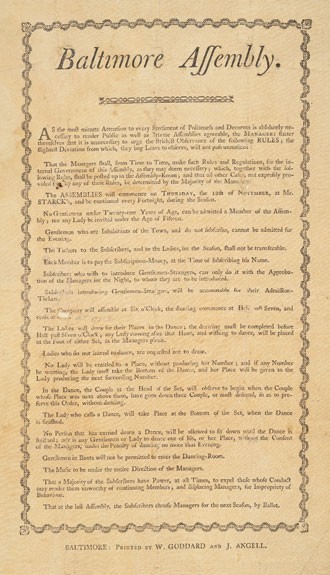
Rules of the Baltimore Assembly, printed by W. Goddard and J. Angell, Baltimore, Maryland, ca. 1789. (Courtesy, Maryland Historical Society.)
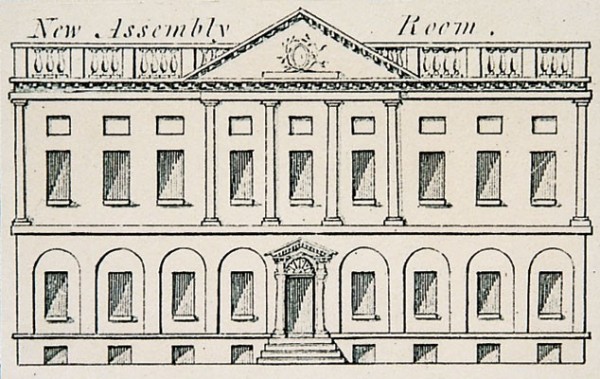
Detail of the map illustrated in fig. 22 showing the building housing the Dancing Assembly Rooms.
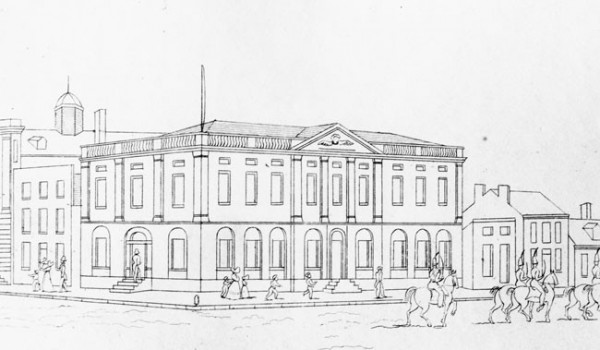
City Assembly Room and Library illustrated in John H. B. Latrobe, Pictures of Baltimore, ca. 1832. (Courtesy, Maryland Historical Society.)
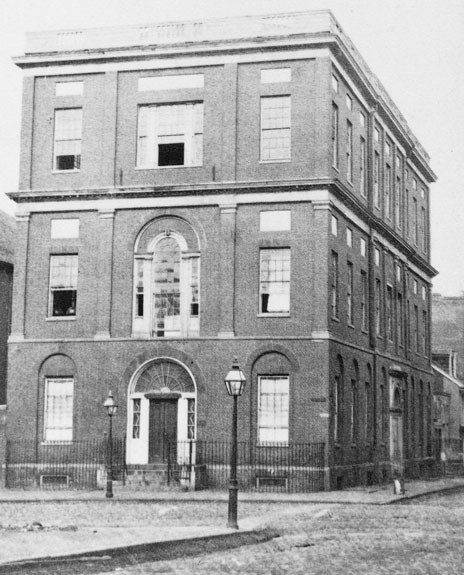
1860s photograph of Central High School, Baltimore, Marlyand. (Courtesy, Maryland Historical Society.) This image shows the Dancing Assembly building after the third story was added in the 1830s. The ballroom, with large palladian window, was on the second floor, apparently extending five bays across the front of the building. The entrance to the rooms occupied by the Library Company of Baltimore is visible at the center.
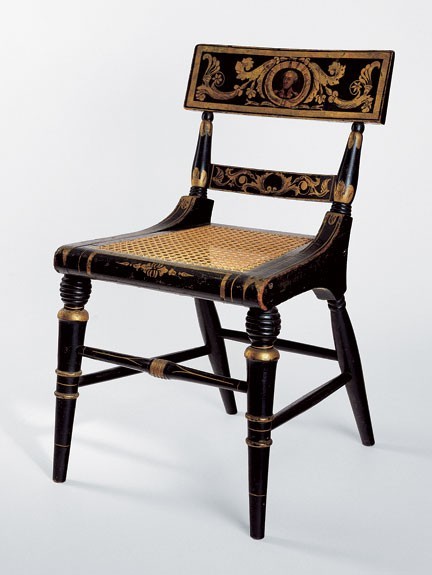
Side chair, Baltimore, Maryland, ca. 1824. Unidentified woods. H. 30 1/2", W. 17 3/4", D. 15 3/8". (Courtesy, Baltimore Museum of Art, gift of Randolph Mordecai; photo, Gavin Ashworth.) Although this set of chairs has yet to be linked to the Finlays, their firm specialized in providing furniture and decorations for symbolic events such as the “silver supper.”

Detail of the decoration on the crest rail of the side chair illustrated in fig. 38. (Photo, Gavin Ashworth.)
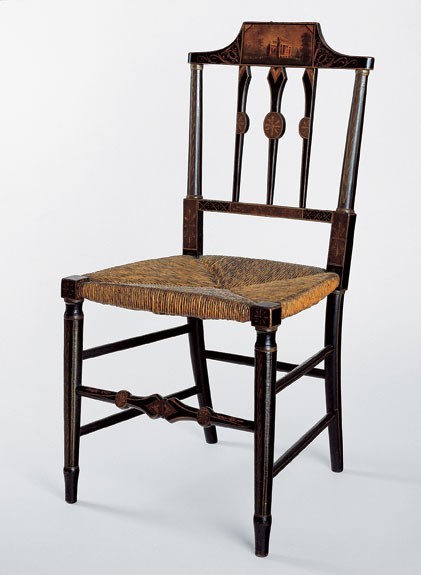
Side chair attributed to the shop of John and Hugh Finlay with crest rail medallion attributed to Francis Guy, Baltimore, Maryland, 1803–1806. Woods not recorded. H. 34 1/4", W. 17 1/2", D. 15 3/4". (Courtesy, Baltimore Museum of Art, Middendorf Foundation Fund; photo, Gavin Ashworth.)
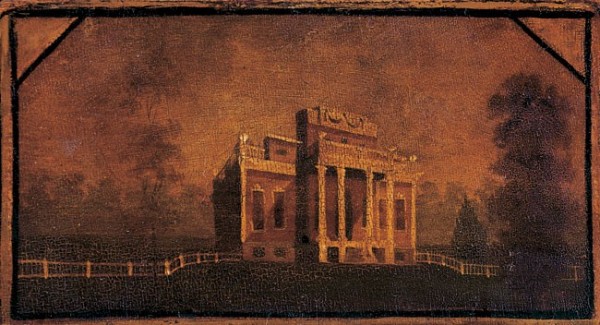
Detail of the decoration on the crest rail of the side chair illustrated in fig. 40 showing the panel depicting Druid Hill. (Photo, Gavin Ashworth.)
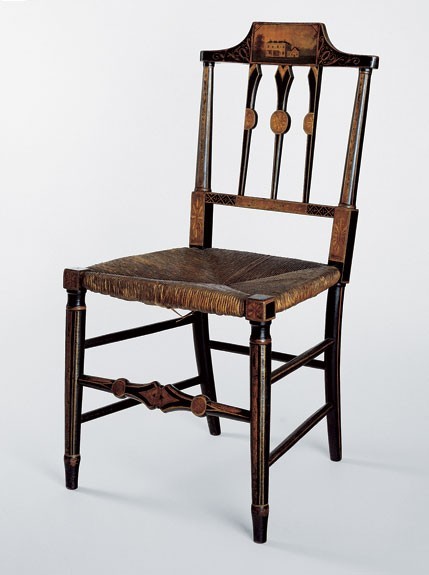
Side chair attributed to the shop of John and Hugh Finlay with crest rail medallion attributed to Francis Guy, Baltimore, Maryland, 1803–1806. Woods not recorded. H. 34 1/4", W. 17 1/2", D. 15 3/4". (Courtesy, Baltimore Museum of Art, Middendorf Foundation Fund; photo, Gavin Ashworth.)

Detail of the decoration on the crest rail of the side chair illustrated in fig. 42 depicting an unidentified country house. (Photo, Gavin Ashworth.)
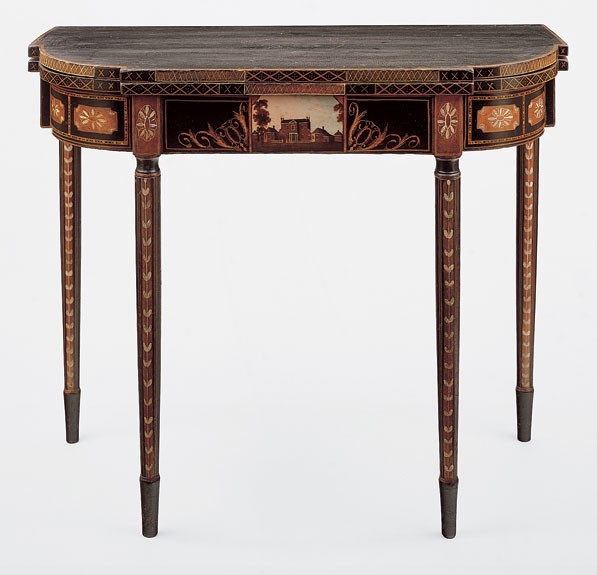
Card table attributed to the shop of John and Hugh Finlay with skirt medallion attributed to Francis Guy, Baltimore, Maryland, 1803–1806. Woods not recorded. H. 29 5/8", W. 35 7/8", D. 17 7/8". (Courtesy, Mount Clare Museum House and the National Society of the Colonial Dames of America in the State of Maryland; photo, Gavin Ashworth.)
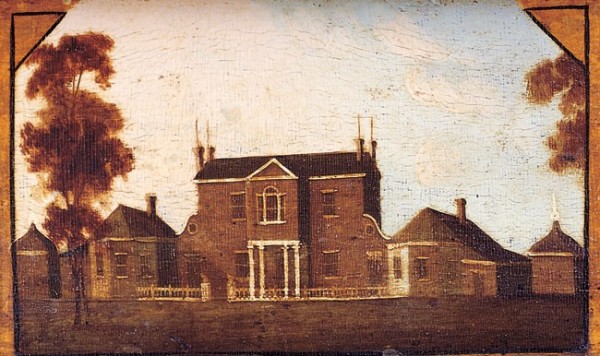
Detail of the decoration on the skirt of the card table illustrated in fig. 44. (Photo, Gavin Ashworth.)
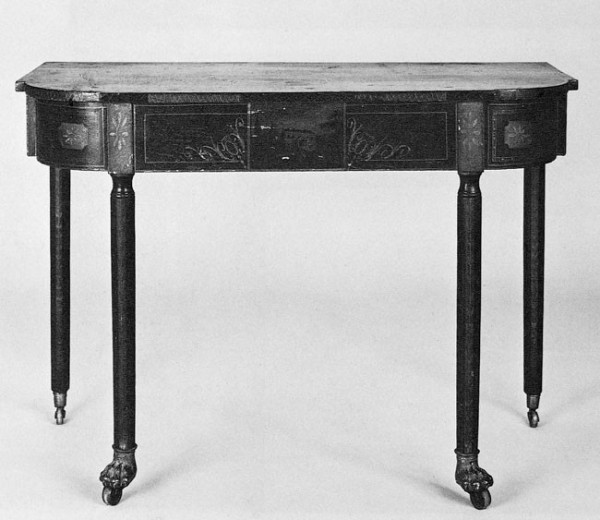
Pier table attributed to the shop of John and Hugh Finlay with skirt medallion attributed to Francis Guy, Baltimore, Maryland, 1803–1806. Woods not recorded. H. 29 1/2", W. 42 1/2", D. 19 7/9". (Private collection; William Voss Elder, III, Baltimore Painted Furniture 1800–1840 [Baltimore, Md.: Baltimore Museum of Art, 1972], p. 38.)

Detail of the decoration on the skirt of the pier table illustrated in fig. 46. The panel depicts a country house, possibly Robert Oliver’s Green Mount.

Armchair attributed to the shop of John and Hugh Finlay with crest rail medallion attributed to Francis Guy, Baltimore, Maryland, 1803–1806. Maple with unidentified ring-porous hardwood. H. 34 1/2", W. 21 3/16", D. 18 1/4". (Collection of Stiles Tuttle Colwill; photo, Gavin Ashworth.)
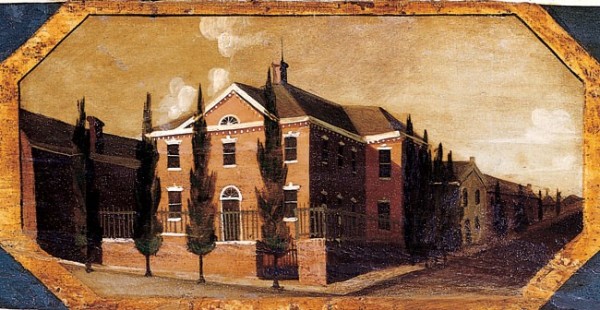
Detail of the decoration on the crest rail of the armchair illustrated in fig. 48. (Photo, Gavin Ashworth.) The structure depicted on the panel has not been identified, but it may represent a public building.
